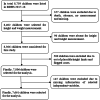Urban-rural differences in the associated factors of severe under-5 child undernutrition based on the composite index of severe anthropometric failure (CISAF) in Bangladesh
- PMID: 34814880
- PMCID: PMC8611976
- DOI: 10.1186/s12889-021-12038-3
Urban-rural differences in the associated factors of severe under-5 child undernutrition based on the composite index of severe anthropometric failure (CISAF) in Bangladesh
Abstract
Introduction: Severe undernutrition among under-5 children is usually assessed using single or conventional indicators (i.e., severe stunting, severe wasting, and/or severe underweight). But these conventional indicators partly overlap, thus not providing a comprehensive estimate of the proportion of malnourished children in the population. Incorporating all these conventional nutritional indicators, the Composite Index of Severe Anthropometric Failure (CSIAF) provides six different undernutrition measurements and estimates the overall burden of severe undernutrition with a more comprehensive view. This study applied the CISAF indicators to investigate the prevalence of severe under-5 child undernutrition in Bangladesh and its associated socioeconomic factors in the rural-urban context.
Methods: This study extracted the children dataset from the 2017-18 Bangladesh Demographic Health Survey (BDHS), and the data of 7661 children aged under-5 were used for further analyses. CISAF was used to define severe undernutrition by aggregating conventional nutritional indicators. Bivariate analysis was applied to examine the proportional differences of variables between non-severe undernutrition and severe undernutrition group. The potential associated socioeconomic factors for severe undernutrition were identified using the adjusted model of logistic regression analysis.
Results: The overall prevalence of severe undernutrition measured by CISAF among the children under-5 was 11.0% in Bangladesh (rural 11.5% vs urban 9.6%). The significant associated socioeconomic factors of severe undernutrition in rural areas were children born with small birth weight (AOR: 2.84), children from poorest households (AOR: 2.44), and children aged < 36 months, and children of uneducated mothers (AOR: 2.15). Similarly, in urban areas, factors like- children with small birth weight (AOR: 3.99), children of uneducated parents (AOR: 2.34), poorest households (APR: 2.40), underweight mothers (AOR: 1.58), mothers without postnatal care (AOR: 2.13), and children's birth order ≥4 (AOR: 1.75), showed positive and significant association with severe under-5 undernutrition.
Conclusion: Severe undernutrition among the under-5 children dominates in Bangladesh, especially in rural areas and the poorest urban families. More research should be conducted using such composite indices (like- CISAF) to depict the comprehensive scenario of severe undernutrition among the under-5 children and to address multi-sectoral intervening programs for eradicating severe child undernutrition.
Keywords: Bangladesh; CIAF; CISAF; Maternal & child health; Severe child undernutrition; Urban-rural disparity.
© 2021. The Author(s).
Conflict of interest statement
The authors declare that they have no competing interests.
Figures
Similar articles
-
Differences in the socio-demographic determinants of undernutrition in children aged <5 years in urban and rural areas of Bangladesh measured by the Composite Index of Anthropometric Failure.Public Health. 2021 Sep;198:37-43. doi: 10.1016/j.puhe.2021.06.027. Epub 2021 Aug 2. Public Health. 2021. PMID: 34352614
-
Prevalence and correlates of the composite index of anthropometric failure among children under 5 years old in Bangladesh.Matern Child Nutr. 2020 Apr;16(2):e12930. doi: 10.1111/mcn.12930. Epub 2019 Dec 22. Matern Child Nutr. 2020. PMID: 31867876 Free PMC article.
-
Exploring under-five child malnutrition in Bangladesh: analysis using the Extended Composite Index of Anthropometric Failure (ECIAF).Public Health Nutr. 2025 Feb 3;28(1):e43. doi: 10.1017/S1368980025000138. Public Health Nutr. 2025. PMID: 39898438 Free PMC article.
-
Nutrition: basis for healthy children and mothers in Bangladesh.J Health Popul Nutr. 2008 Sep;26(3):325-39. doi: 10.3329/jhpn.v26i3.1899. J Health Popul Nutr. 2008. PMID: 18831228 Free PMC article. Review.
-
Risk or associated factors of wasting among under-five children in Bangladesh: A systematic review.Asia Pac J Clin Nutr. 2024 Dec;33(4):457-480. doi: 10.6133/apjcn.202412_33(4).0001. Asia Pac J Clin Nutr. 2024. PMID: 39209356 Free PMC article.
Cited by
-
Determinants of aggregate anthropometric failure among children under-five years in Ethiopia: Application of multilevel mixed-effects negative binomial regression modeling.PLOS Glob Public Health. 2024 Jun 4;4(6):e0003305. doi: 10.1371/journal.pgph.0003305. eCollection 2024. PLOS Glob Public Health. 2024. PMID: 38833430 Free PMC article.
-
A multilevel analysis of factors associated with stunting among children under five years in Lesotho: a study of the lesotho multiple cluster indicator survey 2018.J Health Popul Nutr. 2025 May 24;44(1):168. doi: 10.1186/s41043-025-00901-7. J Health Popul Nutr. 2025. PMID: 40413482 Free PMC article.
-
Magnitudes of Various Forms of Undernutrition Among Children from the Composite Index of Anthropometric Failure in Sub-Saharan Africa: A Systematic Review and Meta-Analysis.Nutrients. 2025 May 27;17(11):1818. doi: 10.3390/nu17111818. Nutrients. 2025. PMID: 40507086 Free PMC article. Review.
-
Examining determinants of stunting in Urban and Rural Indonesian: a multilevel analysis using the population-based Indonesian family life survey (IFLS).BMC Public Health. 2024 May 22;24(1):1371. doi: 10.1186/s12889-024-18824-z. BMC Public Health. 2024. PMID: 38778326 Free PMC article.
-
Undernutrition Among the Children from Different Social Groups in India: Prevalence, Determinants, and Transition Over Time (2005-2006 to 2019-2021).J Racial Ethn Health Disparities. 2024 Dec;11(6):3427-3444. doi: 10.1007/s40615-023-01796-y. Epub 2023 Sep 29. J Racial Ethn Health Disparities. 2024. PMID: 37775680
References
-
- UNICEF, WHO, World bank group. Malnutrition rates remain alarming: stunting is declining too slowly while overweight continues to rise 2016. https://data.unicef.org/wp-content/uploads/2016/09/UNICEF-Joint-Malnutri.... .
MeSH terms
LinkOut - more resources
Full Text Sources
Medical
Miscellaneous




